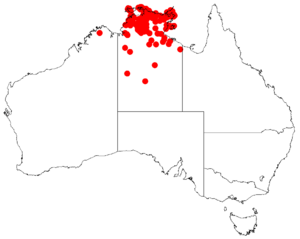Acacia oncinocarpa facts for kids
Quick facts for kids Acacia oncinocarpa |
|
|---|---|
| Scientific classification | |
| Genus: |
Acacia
|
| Species: |
oncinocarpa
|
 |
|
| Occurrence data from AVH | |
Acacia oncinocarpa is a type of shrub or small tree. It belongs to the Acacia family, also known as wattles. This plant is special because it grows naturally only in northern Australia.
Contents
About the Plant
This section describes what Acacia oncinocarpa looks like.
Size and Shape
This shrub or tree usually grows to be about 0.5 to 5 meters (about 1.5 to 16 feet) tall. It often has a rounded shape and feels a bit sticky because of its resin. In windy coastal areas, it might grow flat along the ground.
Bark and Branches
Its bark can be smooth or flaky. It is usually grey to brown in color. The branches have sharp edges and small reddish-brown bumps.
Leaves and Flowers
Like most Acacia plants, it doesn't have typical leaves. Instead, it has what are called phyllodes. These are flattened leaf stalks that act like leaves. The phyllodes are always green. They can be straight or slightly curved. They are about 6 to 15 centimeters (2.4 to 6 inches) long and 5 to 24 millimeters (0.2 to 0.9 inches) wide. Each phyllode has three to five clear lines running along it.
Acacia oncinocarpa blooms between March and August. It grows flower-spikes that look like cylinders. These spikes can be up to 8 centimeters (3 inches) long. They are packed with pale yellow or cream-colored flowers.
Seeds and Pods
After the flowers bloom, woody seed pods grow. These pods are flat and straight, about 5 to 11 centimeters (2 to 4.3 inches) long and 4.5 to 10 millimeters (0.18 to 0.4 inches) wide. Inside the pods are brown seeds. Each seed is about 4 to 7 millimeters (0.16 to 0.28 inches) long. They have a small, cone-shaped part called an aril attached to them.
Where It Grows
This plant is found in a small part of the Kimberley region in Western Australia. It also grows across the tropical "Top End" of the Northern Territory, where it is quite common in a place called Arnhem Land.
Habitat
You can often find Acacia oncinocarpa growing on coastal sand dunes or near cliffs. It likes loamy or sandy soils, which often have gravel. It grows on or around sandstone, granite, or laterite rock. It is usually part of plant communities where Eucalyptus or Melaleuca trees and shrubs grow.

